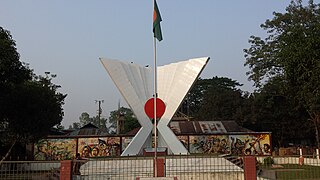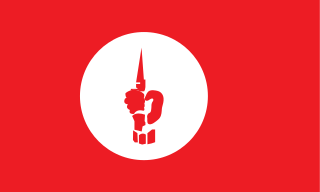
The Bangladesh Armed Forces are the military forces of the People's Republic of Bangladesh. They consist of the three uniformed military services: the Bangladesh Army, the Bangladesh Navy and the Bangladesh Air Force. The Armed Forces are under the jurisdiction of Ministry of Defence of the Government of Bangladesh, and are directly administered by the Armed Forces Division of the Prime Minister's Office. The President of Bangladesh serves as the Commander-in-Chief of the Bangladesh Armed Forces. Bangladesh has the third-largest defence budget in South Asia, The Bangladeshi military is the 37th strongest in the world and the third most powerful military force in South Asia. Border Guard Bangladesh and Bangladesh Coast Guard are under the jurisdiction of the Ministry of Home Affairs. during peacetime, but during wartime they fall under the command of Bangladesh Army and Bangladesh Navy respectively.

Jamalpur is a district in Bangladesh, part of the Mymensingh Division. It was established in 1978.

Muhammad Ataul Gani Osmani was a Bangladeshi military officer and revolutionary. His military career spanned three decades, beginning with his service in the British Indian Army in 1939. He fought in the Burma Campaign during World War II, and after the partition of India in 1947, he joined the Pakistan Army and served in the East Bengal Regiment, retiring as a colonel in 1967. Osmani joined the Provisional Government of Bangladesh in 1971 as the commander-in-chief of the nascent Bangladesh Forces. Regarded as the founder of the Bangladesh Armed Forces, Osmani retired as the first full general from the Bangladesh Army in 1972.

Abdul Kader Siddique is a Bangladeshi politician. He served as a Mukti Bahini member and organizer of the Bangladesh Liberation War. He fought with an estimated 17,000-strong guerrilla force in the Tangail region against the Pakistan Army. The army was called Kaderia Bahini. At the end of the war in 1971, Siddique's forces entered Dhaka along with the Indian forces, signaling the end of the war. He was awarded Bir Uttom by the Government of Bangladesh. Since 1999, he has been serving as the leader of his newly formed party, the Krishak Sramik Janata League.
The Bangladesh Liberation War started on 26 March 1971 and ended on 16 December 1971. Some of the major events of the war are listed in the timeline below.

The Tangail Airdrop was an airborne operation conducted by the Indian Army in order to seize Poongli Bridge and ferry in the Tangail area. The operation, involving 2 Para of the Indian Army's Parachute Regiment is often regarded as one of the largest - if not the largest - airborne operation following World War 2. The operation saw the capture of all objectives and the repulsion of the Pakistan Army's 93rd Infantry Brigade which was attempting to withdraw to Dhaka to bolster its defence.

Operation Jackpot was a codename for three operations undertaken by the Bengali Mukti Bahini in former East Pakistan against the Federation of Pakistan at the climax of the Bangladesh Liberation War.

Bakshiganj is an upazila of Jamalpur District in the Division of Mymensingh, Bangladesh.
Kader Bahini was an independent militia created during the Bangladesh Liberation War of 1971, the other being Mukti Bahini. It was named after its leader, Kader Siddique.
On 25 March 1971, the Pakistani military, supported by paramilitary units, launched the military operation to pacify the insurgent-held areas of East Pakistan, which led to a prolonged conflict with the Bengali Mukti Bahini. Although conventional in nature during March–May 1971, it soon turned into a guerrilla insurgency from June of that year. Indian Army had not directly supported the Bengali resistance but had launched Operation Jackpot to support the insurgency from May 1971.
The Defence of Kamalpur was a second battle fought over Kamalpur near the border between India and East Pakistan during the Bangladesh Liberation War. Kamalpur, a hamlet on the border, was defended by 60-70 regular and paramilitary Pakistani soldiers under the command of Captain Ahsan Malik.

The Battle of Kamalpur, launched against the Pakistan Army, is one of the most significant military engagements fought by the guerrilla armed resistance group, the Mukti Bahini, in 1971 during its war of independence from Pakistan. The Pakistani Army set up a military camp at Kamalpur which was attacked by 1st East Bengal Regiment of Z Force several times. The first attack was made on June 12, and a second attack was made on July 31, 1971, also another attack at 22 October 1971, in total there were 18 battles in Kamalpur.

The Eastern Command of the Pakistan Army was a corps-sized military formation headed by a lieutenant-general, who was designated the Commander Eastern Command. After the partition of India by United Kingdom, the Islamic Republic of Pakistan was divided into two territories separated by 1,000 miles (1,600 km). Most of the assets of the Pakistan armed forces were stationed in West Pakistan; the role of the Pakistan armed forces in East Pakistan was to hold that part of the country until the Pakistani forces defeated India in the west. The Pakistan Army created the Eastern Command, with one commander in the rank of Lieutenant General responsible for the command. The armed forces, had drawn up a plan to defend Dhaka by concentrating all their forces along the Dhaka Bowl.

Prior to Bangladesh Liberation War in 1971, India had no plans for large scale military action in East Pakistan. Since the Sino-Indian War of 1962, the primary objective of the Indian Army Eastern Command was the defence of the Indian northern and eastern borders, defending the "Shiliguri Corridor", and on combating insurgencies raging in Mizoram, Nagaland, Manipur and the Naxalites in West Bengal.

The Mukti Bahini, also known as the Bangladesh Forces, was the guerrilla resistance movement consisting of the Bangladeshi military, paramilitary and civilians during the Bangladesh Liberation War that transformed East Pakistan into Bangladesh in 1971. They were initially called the Mukti Fauj.

Z Force, also known as Tura Brigade, was the first military brigade of Bangladesh Forces, formed during the Liberation War of Bangladesh in 1971 under Major Ziaur Rahman along with the consent of the revolutionary government of Bangladesh in exile. The brigade was formed with the 1st, 3rd and 8th Battalion of East Bengal Regiment on 7 July 1971. It is the first ever complete brigade formed during the Liberation War of Bangladesh in 1971.
The Battle of Shiromoni was fought during the Bangladesh Liberation War and the Indo-Pakistani War of 1971 between the Pakistani Army and the joint forces of the Bangladesh and Indian Army. This was one of the last battles of the Bangladesh Liberation War which continued until 17 December 1971, even though the commander of all Pakistani Forces in Bangladesh had already surrendered on 16 December 1971.
Akbar Bahini was a volunteer force during the Bangladesh Liberation War. Akbar Hossain Miah was the Chairman of Srikul Union in Sreepur PS of Magura District. Immediately after the outbreak of war, Akbar Hossain devoted himself in organising a group of fighters. The majority of the members of Akbar Bahini were extracted from amongst the locals of Sreepur area, but, also included members of the East Pakistan Rifles. Akbar Hossain Miah, formed a group of freedom fighters 'Akbar Bahini'. Akbar Hossain was the commander, and Mollah Nabuwat Ali was its deputy commander.
Latif Bahini was a militia during the Bangladesh Liberation War. Abdul Latif Mirza was a member in the Bangladesh Forces. He planned to build a force in Vodroghat village under Kamarkhand Police Station in Sirajganj District, Rajshahi Division.
Khalil Bahini was a militia during the Bangladesh Liberation War.











